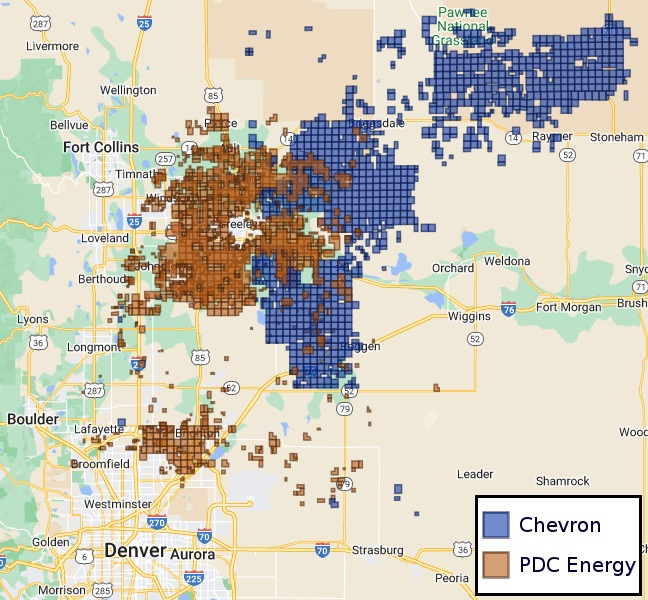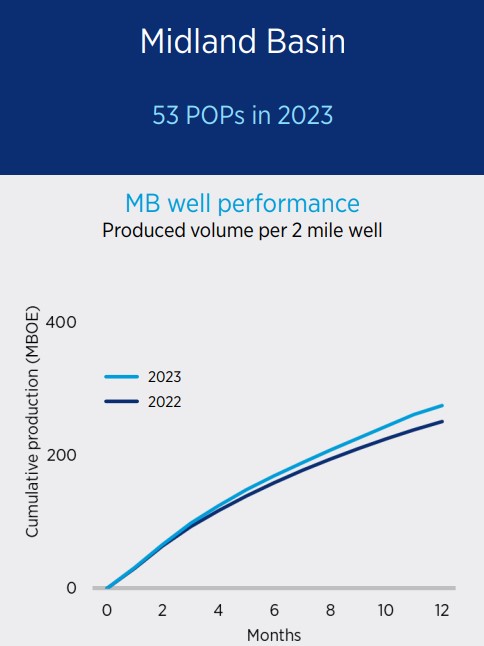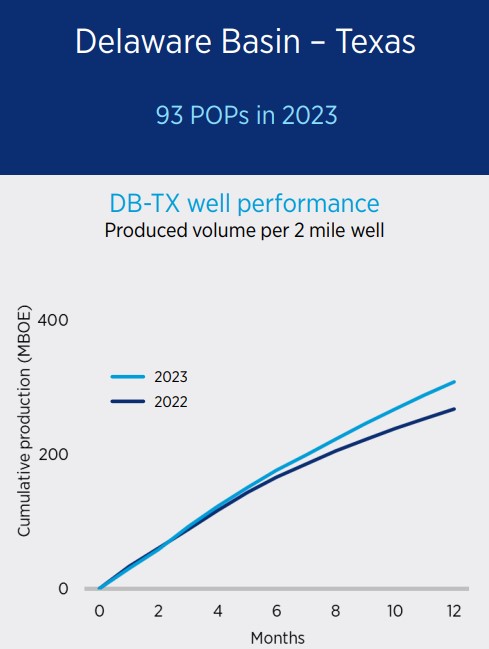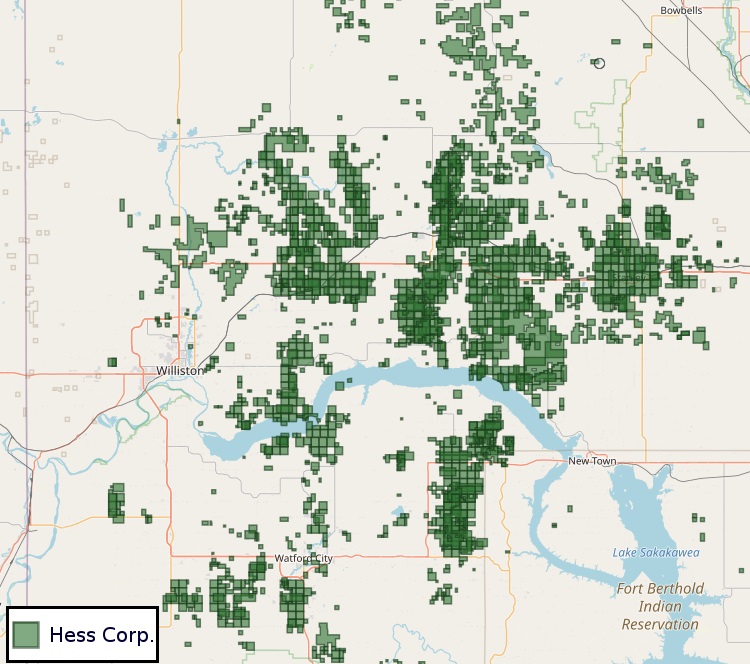
Chevron CEO Mike Wirth, left, and Exxon Mobil CEO Darren Woods, right. (Source: Hart Energy, CERAWeek)
Supermajors Chevron and Exxon Mobil are continuing to lean on U.S. shale for oil and gas production growth.
California-based Chevron Corp. highlighted the importance of its shale portfolio in the Permian Basin and the Rockies during first-quarter earnings on April 26.
Chevron’s worldwide production averaged approximately 3.35 MMboe/d during the first quarter, a 12% increase from 2.98 MMboe/d during first-quarter 2023. U.S. net production increased by 35% over the same period.
Chevron CEO Mike Wirth attributed some of the gains to Chevron’s $6.3 billion acquisition of Colorado producer PDC Energy last year, deepening the company’s footprint in the Denver-Julesburg (D-J) Basin.
D-J Basin production grew by 263,000 boe/d year-over-year in the first quarter—with volumes from Chevron’s legacy Rockies’ portfolio contributing to the growth.

The Permian Basin, the nation’s top oil-producing region, also helped lift the company’s total production in the past year. Chevron’s Permian volumes grew by 142,000 boe/d year-over-year.
Chevron and other large E&Ps with U.S. shale portfolios expect production to grow at a slower pace going forward.
Many shale producers plan to keep their oil and gas output relatively flat this year, while a handful of smaller public E&Ps and private producers aim to raise production.
Chevron said cumulative shale and tight oil and gas production fell by around 17,000 boe/d from the end of 2023 through the first quarter.
Permian volumes averaged 859,000 boe/d during the first quarter, down from 867,000 boe/d during fourth-quarter 2023, Wirth said.
But Chevron’s Permian production is “trending better” during the first half of 2024 than the company originally anticipated, CFO Eimear Bonner said during an April 26 earnings call.
Chevron expects first half of 2024 Permian output to be down less than 2% compared to the fourth quarter; The company had anticipated a decline of between 2% and 4%.
“We've got more wells online and expect to exit the year around 900,000 [boe/d],” Wirth said.
Chevron is driving some D&C efficiencies in the Permian, including “significantly shorter frac-to- [put on production]” cycle times, he said. That resulted in a few additional wells being brought online in the first quarter.
Wirth said Chevron is “seeing strong performance” from new wells drilled in the Permian, including both the Midland and Delaware basins.



The strong Permian performance includes contributions from Chevron’s non-operated joint venture portfolio and its royalty acreage.
Wirth said Chevron’s royalty acreage delivers the company’s highest-return barrels because the company isn’t spending to develop the asset.
“Others are developing it,” Wirth said, “and we saw increased activity that resulted in increased royalty production.”
Taming the Delaware
Some of Chevron’s most productive wells are coming online in the Delaware Basin of West Texas and southeastern New Mexico.
But infrastructure serving the Delaware region, one of the most rural and least developed geographies in the nation, can get constrained trying to keep up with drilling activity.
Midstream takeaway, natural gas processing and produced water handling are areas where Delaware operators are having to invest to keep growing production.
“We've got more development underway this year in the New Mexico portion of the Delaware, which is going to require a build-out of some of this capability—which will be part of what our capital program addresses,” Wirth said.
Constrained natural gas takeaway capacity out of the basin helped push prices at the Waha Hub in West Texas into negative territory during the first quarter.
It’s a big issue for Permian producers—but less of an issue for Chevron.
“We're covered on takeaway capacity out of the basin on oil, NGL and gas well out into the future,” Wirth said. “We’re not exposed to any in-basin discounted pricing as a result of that.”
RELATED
Barnett & Beyond: Marathon, Oxy, Peers Testing Deeper Permian Zones
Bakken boost?
Chevron expects to get a healthy bump in U.S. shale production through its $53 billion acquisition of Hess Corp., one of the largest producers in the Bakken Shale of North Dakota.
Hess’ Bakken output averaged 190,000 boe/d during the first quarter, up from 163,000 boe/d year-over-year.
The Bakken would be a new U.S. shale basin for the California supermajor. But Chevron’s massive acquisition of Hess is less about the Bakken and more about Hess’ ownership interests offshore Guyana—the world’s newest and hottest oil discovery.
Hess is part of an Exxon Mobil-led consortium of producers developing the prolific Stabroek Block offshore Guyana. Exxon owns a 45% stake in the Stabroek joint venture, while Hess owns 30%; the China National Offshore Oil Corp. (CNOOC) owns the remaining 25% interest.
However, the outlook for Chevron closing its acquisition of Hess has been muddied by rival Exxon and the ensuing legal and regulatory red tape.

In Guyana, Exxon Mobil and CNOOC have said they have a right of first refusal over Hess’ 30% ownership stake in the Stabroek Block. Exxon filed an arbitration claim to block Chevron’s acquisition of Hess stake in the offshore block from moving forward.
The arbitration process is “a little bit less well defined at this point,” but a specific timeline will be established by the tribunal, Wirth said during Chevron’s earnings call.
“In our S-4 [filing], we indicated that Hess has asked the tribunal to hear the merits of the cases in the third quarter with an outcome in the fourth quarter, which would allow us to close the transaction shortly thereafter,” Wirth said. “We see no legitimate reason to delay that timeline.”
Exxon Mobil, meanwhile, is deepening its Permian footprint with a $60 billion acquisition of Pioneer Natural Resources, one of the largest oil producers and landowners in the Midland Basin.
Stateside, Exxon and Chevron are each facing scrutiny over their respective acquisitions by the U.S. Federal Trade Commission (FTC).
Chevron and Hess both received an FTC “second request” notification in early December seeking more information on the proposed merger.
That came just days after a similar request was issued to Exxon Mobil and Pioneer Natural Resources regarding their multibillion-dollar combination.
In its own first quarter earnings released April 26, Exxon said it anticipates closing the Pioneer deal during the second quarter, pending regulatory approval.
RELATED
Exxon Versus Chevron: The Fight for Hess’ 30% Guyana Interest
Recommended Reading
E&P Highlights: Feb. 24, 2025
2025-02-24 - Here’s a roundup of the latest E&P headlines, from a sale of assets in the Gulf of Mexico to new production in the Bohai Sea.
Liberty Bolsters Mobile Power Business with Acquisition of IMG Energy
2025-03-05 - Liberty Energy Inc. said March 5 it had purchased IMG Energy Solutions as the company expands its mobile power business.
E&P Highlights: Feb. 10, 2025
2025-02-10 - Here’s a roundup of the latest E&P headlines, from a Beetaloo well stimulated in Australia to new oil production in China.
E&P Highlights: Feb. 3, 2025
2025-02-03 - Here’s a roundup of the latest E&P headlines, from a forecast of rising global land rig activity to new contracts.
Watch for Falling Gas DUCs: E&Ps Resume Completions at $4 Gas
2025-01-23 - Drilled but uncompleted (DUC) gas wells that totaled some 500 into September 2024 have declined to just under 400, according to a J.P. Morgan Securities analysis of Enverus data.
Comments
Add new comment
This conversation is moderated according to Hart Energy community rules. Please read the rules before joining the discussion. If you’re experiencing any technical problems, please contact our customer care team.






